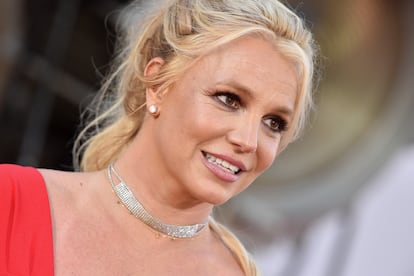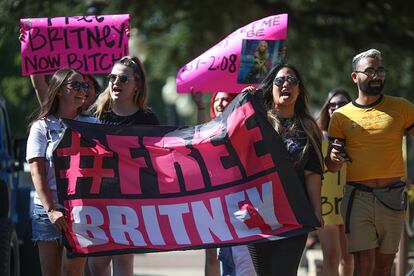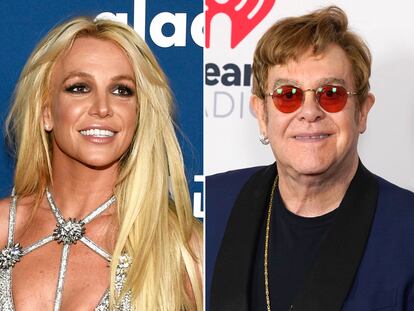Britney Spears’ first year of freedom: Dancing, beaches and bitterness
A year after freeing herself from her father’s conservatorship, the singer has regained control of her life and her narrative. She has used the time to travel, get married and settle scores

In movies, stories end with “The End” and the rolling of the credits. But in real life, they continue to unfold. The story of the conservatorship of singer Britney Spears, who was subjected to strict parental control by court order for 13 years, had a cinematic ending. The princess of pop, locked up in a castle in Las Vegas, was freed by an army of fans, with no other weapon than the hashtag #FreeBritney. A wave of protests began in 2019 when The New York Times began to report on what her followers had been warning for some time: the artist was not well. It sparked a movement. As much as her Instagram account or her show in Las Vegas said otherwise, the singer was a puppet in the hands of her father, who had taken advantage of her psychiatric admission in 2008 to take charge of her life and her fortune. The change in social perception was decisive. On September 30, 2021, just one year ago, Spears finally achieved her freedom. World attention waned, but her life went on.
If there were post-credits scenes in Britney Spears’ movie, they would show her drinking champagne on a paradisiacal beach. Since regaining control of her life, the 40-year-old singer has done what anyone in her situation would do. “She has traveled the world. She has been on the beach practically the whole year,” says Juan Sanguino, journalist and author of the book Britney, One More Time. “Essentially, she has dedicated herself to doing what she likes the most, which is trying on clothes, dancing, doing yoga, being with her boyfriend and being on Instagram. Because she is addicted to Instagram.”
In the last year, the singer has been more present on the social network than on Spotify. She has only released one song, Hold Me Closer, a duet with Elton John, in which they cover the old song by the English artist. In this same time, she has shared 483 photos and an undetermined number of stories on Instagram, causing a cascade of headlines. “For the public, this first year of free Britney has meant the discovery of her as a person,” says Sanguino. “Much has been said about her as an icon, a star, a symbol or a metaphor. But she had never been talked about as a person until now.”
After years under the gag of the conservatorship, Spears is now telling her own story. And she is doing it on Instagram, a platform on which she has 42 million followers and which he uses almost like a virtual diary. On Instagram she publishes her free dance sessions and her home fashion shows, compulsively trying on clothes while swaying her body from side to side, staring at the camera. She announced on the platform that she was going to have her first glass of champagne in 13 years and her first visit to a bar (“I feel so sophisticated,” she said). She shared her first time sailing and her first selfie. “Year of first times … on the bucket list I guess,” she wrote in one post.

She also announced her third pregnancy and subsequent miscarriage. And her third marriage, with the 28-year-old Iranian model Sam Asghari. Getting married and growing her family were two of the singer’s great wishes, which she was unable to fulfill during her conservatorship. Celebrities such as Paris Hilton, Drew Barrymore, Selena Gomez, Madonna and Donatella Versace – who designed her dress – attended the wedding. But there was no trace of the Spears family. The singer of I’m a Slave 4 U is at odds with her father, against whom she is waging a legal battle over the consequences of his guardianship. She is also fighting her sister, brother and mother for their role in the process. The most significant absence at the wedding, however, was that of her children, Sean Preston, 16, and Jayden James, 15, the result of her marriage to dancer Kevin Federline.
The minors explained their absence a few months later in a television interview with their father, in which they confirmed their estrangement from their mother. Following the news, Britney shared a voice message on Instagram, assuring that a part of her had died: “I literally have no purpose anymore. They were my joy. They were my everything. I hope to see them. That’s what I live for. And suddenly they disappear.”
Spears has also gone to Instagram to share details about the conservatorship, posting bitter, emoji-filled declarations that tabloids have analyzed with relish. “I think she is suffering from a clear situation of post-traumatic syndrome,” says Sanguino. “It’s like she had just been released from a kidnapping. She was managing it with a therapist, but the way to learn to live with what she has suffered is also to recognize it, proclaim it and share it.”
She has also used her social networks to settle accounts with former colleagues, perhaps going too far on some occasions. She accused her ex, singer Justin Timberlake, of using her to gain “fame and attention,” in a post that she deleted after a few minutes. “This new Britney is more badass, more forward, more inappropriate from the media point of view,” Sanguino concedes. “But it’s also more authentic, more real.”
It has only been a year since the story of Britney Spears, the icon, ended. That of Britney Spears, the woman, began to be narrated in the first person. Like any human story, it has its shade of black and white. It says a lot about the past of the princess of pop, but even more about her audience. “Society has changed,” says Sanguino. “Her case has become a symbol of everything we had to leave behind, of that cruelty, of that wild misogyny of the 2000s. People saw in Britney a chance to atone socioculturally.” She has taken that opportunity to stop living as an icon and start living as a free woman.
Tu suscripción se está usando en otro dispositivo
¿Quieres añadir otro usuario a tu suscripción?
Si continúas leyendo en este dispositivo, no se podrá leer en el otro.
FlechaTu suscripción se está usando en otro dispositivo y solo puedes acceder a EL PAÍS desde un dispositivo a la vez.
Si quieres compartir tu cuenta, cambia tu suscripción a la modalidad Premium, así podrás añadir otro usuario. Cada uno accederá con su propia cuenta de email, lo que os permitirá personalizar vuestra experiencia en EL PAÍS.
¿Tienes una suscripción de empresa? Accede aquí para contratar más cuentas.
En el caso de no saber quién está usando tu cuenta, te recomendamos cambiar tu contraseña aquí.
Si decides continuar compartiendo tu cuenta, este mensaje se mostrará en tu dispositivo y en el de la otra persona que está usando tu cuenta de forma indefinida, afectando a tu experiencia de lectura. Puedes consultar aquí los términos y condiciones de la suscripción digital.
More information
Últimas noticias
Welcome to the post-religion era: The idea of Christianity as the absolute truth has become obsolete
‘I thought you would like it’: The risky sexual practice popularized by TV shows and TikTok
The digitalization of tourism: ‘They promise experiences and gave us the worst possible one’
Mexican peso defies uncertainty with forecasts of a new period of stability in 2026
Most viewed
- Sinaloa Cartel war is taking its toll on Los Chapitos
- Reinhard Genzel, Nobel laureate in physics: ‘One-minute videos will never give you the truth’
- Oona Chaplin: ‘I told James Cameron that I was living in a treehouse and starting a permaculture project with a friend’
- Why the price of coffee has skyrocketed: from Brazilian plantations to specialty coffee houses
- Silver prices are going crazy: This is what’s fueling the rally











































